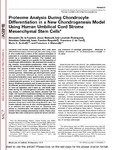Mostrar o rexistro simple do ítem
Proteome analysis during chondrocyte differentiation in a new chondrogenesis model using human umbilical cord stroma mesenchymal stem cells
| dc.contributor.author | Fuente, Alexandre de la | |
| dc.contributor.author | Mateos, Jesús | |
| dc.contributor.author | Lesende-Rodríguez, Iván | |
| dc.contributor.author | Calamia, Valentina | |
| dc.contributor.author | Fuentes Boquete, Isaac Manuel | |
| dc.contributor.author | De-Toro, Javier | |
| dc.contributor.author | Arufe, M.C. | |
| dc.contributor.author | Blanco García, Francisco J | |
| dc.date.accessioned | 2017-03-28T11:37:23Z | |
| dc.date.available | 2017-03-28T11:37:23Z | |
| dc.date.issued | 2011-10-17 | |
| dc.identifier.citation | De la Fuente A, Mateos J, Lesende-Rodríguez I, Calamia V, Fuentes-Boquete I, de Toro FJ, Arufe MC, Blanco FJ. Proteome analysis during chondrocyte differentiation in a new chondrogenesis model using human umbilical cord stroma mesenchymal stem cells. Mol Cell Proteomics. 2012 Feb;11(2):M111.010496. | es_ES |
| dc.identifier.issn | 1535-9476 | |
| dc.identifier.issn | 1535-9484 | |
| dc.identifier.uri | http://hdl.handle.net/2183/18340 | |
| dc.description.abstract | [Abstract] Umbilical cord stroma mesenchymal stem cells were differentiated toward chondrocyte-like cells using a new in vitro model that consists of the random formation of spheroids in a medium supplemented with fetal bovine serum on a nonadherent surface. The medium was changed after 2 days to one specific for the induction of chondrocyte differentiation. We assessed this model using reverse transcriptase-polymerase chain reaction, flow cytometry, immunohistochemistry, and secretome analyses. The purpose of this study was to determine which proteins were differentially expressed during chondrogenesis. Differential gel electrophoresis analysis was performed, followed by matrix-assisted laser desorption/ionization mass spectrometry protein identification. A total of 97 spots were modulated during the chondrogenesis process, 54 of these spots were identified as 39 different proteins and 15 were isoforms. Of the 39 different proteins identified 15 were down-regulated, 21 were up-regulated, and 3 were up- and down-regulated during the chondrogenesis process. Using Pathway Studio 7.0 software, our results showed that the major cell functions modulated during chondrogenesis were cellular differentiation, proliferation, and migration. Five proteins involved in cartilage extracellular matrix metabolism found during the differential gel electrophoresis study were confirmed using Western blot. The results indicate that our in vitro chondrogenesis model is an efficient and rapid technique for obtaining cells similar to chondrocytes that express proteins characteristic of the cartilage extracellular matrix. These chondrocyte-like cells could prove useful for future cell therapy treatment of cartilage pathologies. | es_ES |
| dc.description.sponsorship | info:eu-repo/grantAgreement/MICINN/Programa Nacional de Internacionalización de la I+D/PLE2009-0144/In situ Tissue Engineering using Stem Cells and Functional Biomaterials to Repair Articular Cartilage: An ''in Vivo Model" | es_ES |
| dc.language.iso | eng | es_ES |
| dc.publisher | American Society for Biochemistry and Molecular Biology | es_ES |
| dc.relation.uri | http://dx.doi.org/10.1074/mcp.M111.010496 | es_ES |
| dc.title | Proteome analysis during chondrocyte differentiation in a new chondrogenesis model using human umbilical cord stroma mesenchymal stem cells | es_ES |
| dc.type | info:eu-repo/semantics/article | es_ES |
| dc.rights.access | info:eu-repo/semantics/openAccess | es_ES |
| UDC.journalTitle | Molecular & Cellular Proteomics | es_ES |
| UDC.volume | 11 | es_ES |
| UDC.issue | 2 | es_ES |
Ficheiros no ítem
Este ítem aparece na(s) seguinte(s) colección(s)
-
GI-TCMR - Artigos [131]
-
INIBIC-TCMR - Artigos [102]
-
INIBIC- REUMA - Artigos [185]






